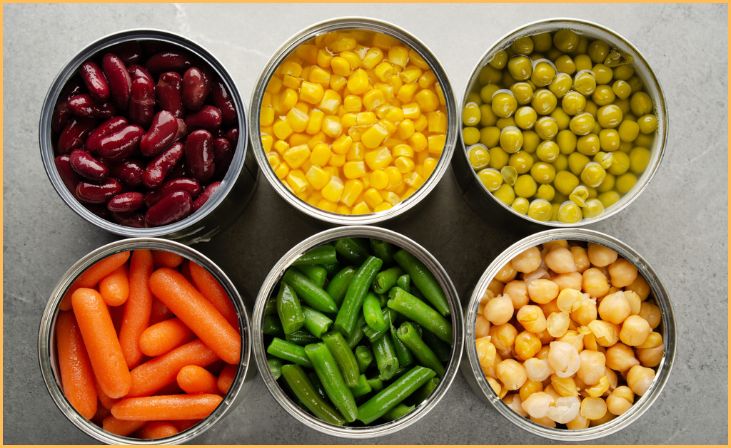In the pursuit of a healthy lifestyle and weight management, the choices we make in our daily diet play a pivotal role. While vegetables are generally celebrated as nutritional powerhouses, some may inadvertently contribute to weight gain when consumed in excess. This blog post sheds light on “10 Vegetables That Could Be Sneaking Extra Pounds onto Your Plate,” exploring the surprising factors that can impact your weight-loss journey. From seemingly innocent veggies to understanding portion control, we delve into the nuances of vegetable consumption that might be hindering your wellness goals. Join us as we navigate the garden of potential pitfalls and empower you to make informed choices for a balanced and sustainable approach to weight management.
Try These Vegetables That Could Be Sneaking Extra Pounds
When it comes to maintaining a healthy weight, vegetables are often celebrated as a cornerstone of a balanced diet. However, not all vegetables are created equal, and some innocent-looking veggies might actually be contributing to unwanted weight gain. In this article, we’ll uncover the surprising truth about 10 vegetables that could secretly be making you gain weight.
Quick Link: Best Vegetable Beef Soup Pioneer Woman: Tastiest Soup Ever!
1. Potatoes

Potatoes, revered as a versatile and nutritious dietary staple, bear a dual nature that hinges on their preparation. While inherently rich in valuable nutrients, the culinary choices we make can sway the impact on our waistline. Frying these tubers into golden, crispy French fries or crafting them into velvety mashed potatoes, laden with generous amounts of butter and cream transforms their profile, significantly elevating their calorie count.
It’s not the potatoes themselves but rather the decadent preparations that may swiftly contribute to extra pounds. Recognizing the potential pitfalls of indulgent potato dishes highlights the importance of mindful cooking methods and portion control, allowing us to savor the nutritional benefits of this root vegetable without compromising our weight management goals.
2. Corn
Corn, a quintessential summertime delight, is cherished whether freshly boiled or grilled. In its natural state, corn is a relatively low-calorie option, delivering some nutritional benefits. The challenge arises when we succumb to the temptation of slathering it with butter or transforming it into creamy corn dishes. While those buttered corn cobs and comforting bowls of creamed corn are undeniably delicious, they come at a caloric cost due to the added fats.
It’s a fine balance between relishing the natural sweetness of corn and being mindful of the caloric impact of indulgent preparations. Understanding the nuances of corn’s culinary transformations allows us to enjoy this seasonal favorite without compromising our calorie-conscious choices during the sunny months.
3. Avocado
Despite its superfood status, avocados come with a caveat – they pack a calorie punch. While these creamy delights offer a wealth of healthy fats and valuable nutrients, their calorie density is worth noting. It’s easy to unintentionally surpass recommended portion sizes, particularly when diving into a bowl of guacamole with a mountain of tortilla chips.
Balancing the nutritional benefits of avocados with mindful consumption is paramount, allowing us to appreciate their healthful qualities without inadvertently overindulging. Navigating the allure of avocados involves savoring their richness in moderation, ensuring that we harness their nutritional prowess while maintaining a conscious eye on our overall calorie intake.
4. Peas
Peas, often considered innocuous, harbor the potential to contribute to weight gain when not approached mindfully. These petite green gems boast a rich nutritional profile, yet their role in calorie-dense culinary creations can be deceiving. When incorporated into creamy pasta dishes or nestled within cheesy casseroles, the overall calorie content of the meal can escalate unexpectedly. Caution is advised when peas find themselves swimming in rich sauces or becoming integral to cheesy concoctions.
Appreciating the nutrient density of peas calls for a discerning eye in culinary endeavors, ensuring that their healthful attributes are not overshadowed by the calorie-laden companions with which they may be paired. Embracing peas in moderation allows us to relish their nutritional benefits without compromising our weight management goals.
Also Read: Lotus Root: A Versatile Root Vegetable
5. Sweet Potatoes

While sweet potatoes are frequently celebrated as a healthier alternative to their regular counterparts, their virtuous reputation may be compromised when dressed up with sweeteners, butter, or even marshmallows. Despite their vibrant hue and commendable nutrient profile, the calorie content of sweet potatoes can swiftly escalate, particularly in the context of delectable casseroles or candied sweet potato creations. It’s crucial to approach these culinary endeavors with mindfulness, as the additions that enhance flavor can also introduce additional calories.
Balancing the nutritional benefits of sweet potatoes with prudent choices in preparation allows us to relish their natural goodness without inadvertently transforming them into higher-calorie indulgences. Navigating the world of sweet potatoes involves savoring their inherent healthfulness while being cognizant of the potential caloric extravagance that tempting preparations may introduce.
6. Brussels Sprouts
The seemingly low-calorie allure of Brussels sprouts can take a calorific turn when paired with bacon, butter, or enveloped in heavy sauces. These petite cabbages, while inherently nutritious, undergo a transformation when subjected to indulgent cooking methods and rich accompaniments. The addition of bacon introduces savory notes, but it also introduces extra calories that may go unnoticed. Butter, often employed for flavor enhancement, contributes not only richness but also an uptick in the overall calorie content. The drenching of Brussels sprouts in heavy sauces amplifies their potential to become a calorie-dense dish.
Mindful consideration of cooking methods and complementary ingredients is essential to preserving the nutritional integrity of Brussels sprouts, allowing us to appreciate their healthful attributes without unintentionally embracing a higher-calorie rendition. Balancing the desire for flavor with an awareness of the calorie implications ensures that Brussels sprouts remain a wholesome choice on the plate.
7. Cauliflower
Cauliflower’s chameleon-like adaptability in the kitchen can be a double-edged sword for weight-conscious individuals. On one hand, this versatile vegetable shines as a low-calorie star when prepared simply, offering a healthy canvas for various culinary creations. However, its transformative nature can turn against weight goals when it morphs into calorie-laden versions, such as rich, cheesy casseroles or deep-fried dishes. The seemingly innocent cauliflower takes on a different guise when enveloped in decadent sauces or hidden beneath layers of cheese.
Caution is advised when indulging in preparations that mask its inherent lightness, as the calorie content can soar unexpectedly. Appreciating the duality of cauliflower involves balancing its potential for simplicity with an awareness of its susceptibility to becoming a calorie-rich indulgence, ensuring that its adaptability serves our health goals rather than hindering them.
8. Zucchini
Zucchini, heralded as a diet-friendly vegetable with its mild flavor, offers a versatile canvas for culinary exploration. However, the seemingly innocent zucchini can undergo a transformation when battered and deep-fried into tempting fritters or used to bulk up calorie-rich pasta dishes. In these indulgent preparations, its diet-friendly reputation takes a backseat as the calorie impact rises considerably.
Maintaining balance is paramount when incorporating zucchini into meals, appreciating its inherent healthfulness while being mindful of the cooking methods and accompanying ingredients. The versatility of zucchini should be embraced in ways that enhance its natural goodness rather than compromise it with unnecessary calories.
Navigating the world of zucchini involves savoring its diet-friendly attributes while treading lightly in preparations that might veer toward the calorie-dense spectrum. Balancing the flavors and textures allows zucchini to retain its status as a wholesome addition to meals without inadvertently becoming a caloric culprit.
Also Check: The Secret of Longevity: 6 High-Protein Foods from Blue Zones
9. Eggplant
Eggplant, celebrated for its flavor-absorbing prowess, stands as a culinary delight, but its preparation plays a pivotal role in its calorie impact. Take Eggplant Parmesan, for example—a beloved dish involving frying the eggplant and layering it with cheese and sauce. While undeniably delicious, this preparation elevates the calorie content considerably. The key lies in being mindful of the cooking techniques employed with eggplant, ensuring that its natural attributes aren’t overshadowed by additional calories.
Appreciating the versatility of eggplant involves exploring cooking methods that enhance its inherent goodness without unintentionally contributing to extra pounds. By balancing flavor infusion with an awareness of calorie implications, you can relish the delights of eggplant without compromising your dietary goals. Navigating the world of this absorbent vegetable involves savoring its culinary potential while making mindful choices that align with your health and wellness objectives.
10. Canned Vegetables

The convenience of canned vegetables comes with a caveat, as some varieties may conceal sneaky ingredients. While canned vegetables are a time-saving option, they occasionally come laced with added sugars or high-sodium sauces designed to elevate flavor. These seemingly innocuous enhancements, however, can significantly inflate the calorie content compared to their fresh or frozen counterparts.
Opting for fresh or frozen alternatives whenever possible becomes a strategic choice to sidestep these hidden hazards and maintain a more health-conscious approach. By prioritizing whole, unprocessed options, you not only evade the pitfalls of added sugars and sodium but also ensure a more wholesome and nutrient-dense addition to your meals.
Navigating the aisle of canned goods involves a discerning eye for labels and a commitment to making choices that align with your nutritional goals, promoting both convenience and health in your dietary endeavors.
While vegetables are generally fantastic allies in maintaining a healthy weight, the way you prepare and consume them can impact their calorie content. Being mindful of cooking methods, portion sizes, and added ingredients can help you enjoy these veggies without unintentionally sabotaging your weight management goals.
Final Words
As we conclude our exploration into the vegetables that might be adding extra pounds to your plate, it’s essential to approach dietary choices with a balanced perspective. While vegetables are a crucial component of a healthy diet, understanding their caloric and carbohydrate content can be instrumental in achieving weight management goals. Embrace a diverse and colorful array of vegetables, practice portion control, and tailor your choices to align with your individual nutritional needs. By making informed decisions, you can cultivate a sustainable and enjoyable approach to a healthier lifestyle.
FAQs
No, not all vegetables have the same impact on weight. While most vegetables are low in calories and high in nutrients, some, when consumed in large quantities or certain preparations, can contribute more calories and carbohydrates. It’s essential to be mindful of portion sizes.
No, moderation is key. The goal is not to avoid these vegetables entirely but to be mindful of portion sizes and cooking methods. Including a variety of vegetables in your diet can contribute to overall health, and with proper portion control, you can enjoy them as part of a balanced eating plan.
To include these vegetables in a weight-loss-friendly diet, focus on portion control, opt for lighter cooking methods like steaming or roasting, and balance your meals with a variety of nutrient-dense foods. It’s about making mindful choices that align with your overall health goals.
Yes, many vegetables are excellent choices for weight loss due to their low calorie and high fiber content. Leafy greens, cruciferous vegetables, and those with high water content, like cucumbers and celery, can be particularly helpful in creating a sense of fullness with fewer calories.







